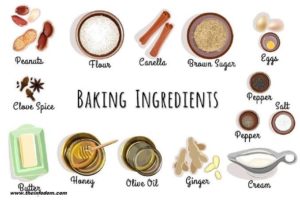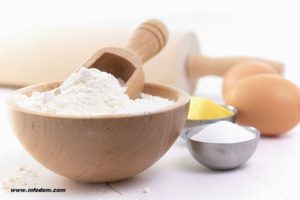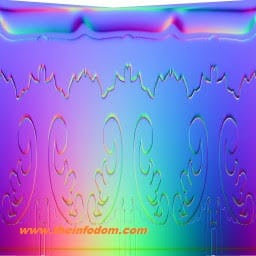Table of Contents
basics of baking ingredients

History of Baking
Basics of baking ingredients are very important to know the baker because in baking we should use every ingredient by purpose. Baking is both a science and an art. This article explains the science behind this. In every recipe for baking, every ingredient has a purpose. In a cake, for example, the flour gives the structure, the eggs add to the ingredients, the baking powder and the baking soda make it rise, the fats such as butter and oil make it less chewable and the sugar sweetens it and keeps it moist.
The world’s oldest oven was discovered in (Croatia) in 2014 dated back 6500 years ago. Enceinte Egyptians baked their bread using yeast they used to brew beer. Bread baking begins in Ancient Greece in around 600Bc leading to the invention of enclosed ovens. Baking flourished during the Roman Empire. Beginning around 300Bc, the pastry cook become an acceptation known as Pstillarium. Because of historical social and familial roles, baking has traditionally been performed at home by women for day-to-day meals and by men in bakeries and restaurants for local consumption. When production was industrialized, baking was automated by machines in large factories. The art of baking remains a fundamental skill and is important for nutrition, as baked goods, especially bread, are a common and important food, both from an economic and cultural point of view. A person who prepares baked goods as a profession is called
Processes taking place while baking food
- Fat melt
- Gases form and expand
- Micro-organisms die
- Sugar Dissolve
- Egg and glutton protein
- Starches Gelatinize
- Gases evaporate
- Caramelization and Millard brewing occurs or crust
- Enzymes occur to nutrients
Baked Goods
- Cakes
- Pastries
- Pies
- Tarts
- Quiches
- Cookies
- Scones
- Crackers
- Pretzels- Bar snack
- Meatloaf
- Chicken or fish
- En cruet – Warped in pastry
- Beef wellington
- Crème caramel
- Crème Brule
- Soufflé
- Baked Alaska
- Meringue
- Pizza
- Baked potatoes
- Pasta dishes
Basic Ingredients used in baking
- Flour
- Baking Powder
- Egg (protein)
- Yeast
- Butter/oil
- Sugar/Brown sugar
- Honey
- Cocoa powder
- Vanilla extract
Flour (Basic of baking)
Flour provides the structure of baked goods. Wheat flour contains proteins that interact with each other when mixed water, forming gluten.
It is the elastic gluten framework that stretches to contain and expand the leaving gases during rising. The protein content of flour affects the strength of the dough. The different wheat types contain different amounts of gluten forming the protein.
Hard wheat High protein content
Soft wheat low protein content
In yeast bread strong gluten from work is desirable, but in cakes, cookies and quick bread high protein flour make a tough product.
Bread Flour
Bread flour is hard flour with about 12% of protein, bread flour is used for great raised bread because the dough produces has more gluten then dough made with other types of flour. Sufficient gluten produces a light loaf with good volume. Slices hold together rather than crumble.

Cake flour
Cake flour is soft that has 7.5% protein The lower gluten have a tend caves, the product to have a tender. The more crumbly texture that is desirable in cakes.
All-purpose flour:
All-purpose flour is blended during milling to achieve a protein content of 10.5%.this is the medium protein flour that can be used for all-purpose flour in place of cake flours. In a recipe substitute 1 cupcake minus 2 tbsp all-purpose flour for 1 cup cake flour.
Whole wheat four:
Whole wheat flour may be substituted for part of the white flour in yeast and quick bread, but the finished product will reduce whole wheat or contain the nutrients germ and bran as well as the endosperm of the wheat kernel.
Bran parties cut through the gluten driving mixture and kneading of bread dough resulting in a smaller heavier loaf. In substituting a very grand whole wheat flour for all-purpose flour use 1 cup plus 2tbsp whole wheat flour for ever cup of all-purpose flour. To substitute to whole wheat flour in a white bread recipe use half whole wheat and half bread flour for the best result.1+1=2tbsp
Cornmeal:
Cornmeal coarsely ground dried corn. Corn flour is made more finely ground corn. Both cornmeal and flour contain 7.8% protein on a dry basis neither cornmeal or corn flour will produce gluten. A graining texture in cornbreads/meal can be avoided by mixing the cornmeal with the liquid of the recipe, baring to the boil and cooling before mixing with other ingredients.
Rice flour:
Rice flour has about 6.5-7% protein and does not form gluten, for example, who did not tolerate gluten, rice flour is an acceptable substitute for wheat, barley rye or oat flour. In baked products, 7/8 cup of non-wax nice flour is usually used in place of 1cup of all-purpose or wheat flour.
Liquids:
- Milk: milk is used in baked products to improve texture and mouthfeel. The protein in milk also gives a soft crumbed structure in cakes. It also contributes to the cakes’ moisture, color, and flavor of a baked product. the cake that contains milk tends to have a longer shelf life.
Raising agent:
1-Baking powder:
Baking powder is probably the most common raising agent in baked products like cake cookies and quick bread. It is made up of bicarbonate of soda and creams tarter(being an acidic) baking powder is a chemical raising agent.
2-yeast:
Yeast belongs to the fungus family it is formenents carbohydrates (sugar) to produce carbonate oxide gas and alcohol, which rises and east products giving it volume and texture, these by-products of yeast also contribute to the color and aroma of bread and other lasted product.
3-Eggs:
Eggs are another basic ingredient in any product, they provide structure raising flavor and moisture, the also tenderize cakes and add color nutria valued.
4 cream of tartar:-
This is not used alone as a raising agent but sometimes used with bicarbonate of soda in recipes to replace baking powder.
Sweeteners
1-Caster sugar:
This is the sugar mostly used commonly in cake making but especial Wished sponge cakes, creamed mixture and meringues. The small regular grains ensure that it blends smoothy in mixing to give an even texture.
Granulated sugar:
This has a coarser texture than caster sugar and is best used for rubbed in cake and cookies mixture or in the melting method. If used in the cream mixture it will give a slight grittiness and speckled appearances to the cake and cookies. Neither would the cake have such a good volume.
Condensed milk:
This is used as a sweetener in some recipes. It is condensed milk from which half the water content has been removed and in which sugar has been added (it makes wonderful toffee and fudge)
Honey:
The world’s oldest sweetener used clear or runny honey in cake making as this dissolves more quickly.
Chocolate:
The different types and their uses are desirable as you required.
Milk chocolate:
Milk chocolate has the addition of full cream milk as well as sugar to the cocoa butter and its sweetener the flavor is therefore lost in baking. it is good for decoration and always popular with children. further, Milk chocolate is also available as chips.
Cooking chocolate
Unsweetened pure or cooking chocolate is often used by professionals in baking. it is available from cake shops. Many of these are also milk order suppliers and is sold in blocks from a chocolate chip.
basics of baking ingredients
